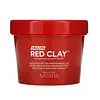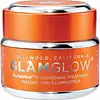What's inside
What's inside
 Key Ingredients
Key Ingredients

 Benefits
Benefits

 Concerns
Concerns

 Ingredients Side-by-side
Ingredients Side-by-side

Water
Skin ConditioningKaolin
AbrasiveSilica
AbrasiveButylene Glycol
HumectantSolum Diatomeae
AbrasiveHectorite
AbsorbentAlcohol Denat.
AntimicrobialGlyceryl Stearate
EmollientGlycerin
Humectant1,2-Hexanediol
Skin ConditioningHydroxyacetophenone
AntioxidantCI 77491
Cosmetic ColorantCellulose Gum
Emulsion StabilisingTetrasodium Pyrophosphate
BufferingXanthan Gum
EmulsifyingSalicylic Acid
MaskingPaullinia Cupana Fruit Extract
Skin ConditioningLactic Acid
BufferingCitrus Aurantium Bergamia Fruit Oil
MaskingDisodium EDTA
Ethylhexylglycerin
Skin ConditioningTromethamine
BufferingLavandula Angustifolia Oil
MaskingPortulaca Oleracea Extract
Skin ConditioningRosmarinus Officinalis Leaf Oil
MaskingAniba Rosaeodora Wood Oil
AstringentLimonene
PerfumingLinalool
PerfumingWater, Kaolin, Silica, Butylene Glycol, Solum Diatomeae, Hectorite, Alcohol Denat., Glyceryl Stearate, Glycerin, 1,2-Hexanediol, Hydroxyacetophenone, CI 77491, Cellulose Gum, Tetrasodium Pyrophosphate, Xanthan Gum, Salicylic Acid, Paullinia Cupana Fruit Extract, Lactic Acid, Citrus Aurantium Bergamia Fruit Oil, Disodium EDTA, Ethylhexylglycerin, Tromethamine, Lavandula Angustifolia Oil, Portulaca Oleracea Extract, Rosmarinus Officinalis Leaf Oil, Aniba Rosaeodora Wood Oil, Limonene, Linalool
Water
Skin ConditioningSilica
AbrasiveKaolin
AbrasiveCetyl Alcohol
EmollientC12-15 Alkyl Benzoate
AntimicrobialButylene Glycol
HumectantNiacinamide
SmoothingAcetyl Glucosamine
Skin ConditioningPolymethylsilsesquioxane
Pumice
AbrasiveGlyceryl Stearate
EmollientPEG-100 Stearate
Pentylene Glycol
Skin ConditioningDiamond Powder
AbrasiveRosmarinus Officinalis Leaf Extract
AntimicrobialBetula Alba Leaf Extract
AstringentLactic Acid
BufferingPaeonia Suffruticosa Root Extract
Skin ProtectingTetrahexyldecyl Ascorbate
AntioxidantBetula Pendula Wood Powder
Skin ConditioningSalicylic Acid
MaskingLilium Candidum Bulb Extract
Skin ConditioningGlycerin
HumectantRibes Nigrum Seed Oil
EmollientSolidago Virgaurea Extract
Skin ConditioningOctyldodecyl Oleate
EmollientEthylhexylglycerin
Skin ConditioningRosa Canina Flower Extract
AstringentOctyldodecanol
EmollientCamellia Sinensis Leaf Extract
AntimicrobialAllantoin
Skin ConditioningJasminum Officinale Flower Extract
MaskingTocopheryl Acetate
AntioxidantOctyldodecyl Stearoyl Stearate
EmollientMagnesium Aluminum Silicate
AbsorbentXanthan Gum
EmulsifyingParfum
MaskingBenzyl Alcohol
PerfumingAlpha-Isomethyl Ionone
PerfumingBenzyl Benzoate
AntimicrobialLinalool
PerfumingAmyl Cinnamal
PerfumingHexyl Cinnamal
PerfumingBenzyl Salicylate
PerfumingLimonene
PerfumingGeraniol
PerfumingDisodium EDTA
Potassium Sorbate
PreservativePhenoxyethanol
PreservativeCI 77891
Cosmetic ColorantWater, Silica, Kaolin, Cetyl Alcohol, C12-15 Alkyl Benzoate, Butylene Glycol, Niacinamide, Acetyl Glucosamine, Polymethylsilsesquioxane, Pumice, Glyceryl Stearate, PEG-100 Stearate, Pentylene Glycol, Diamond Powder, Rosmarinus Officinalis Leaf Extract, Betula Alba Leaf Extract, Lactic Acid, Paeonia Suffruticosa Root Extract, Tetrahexyldecyl Ascorbate, Betula Pendula Wood Powder, Salicylic Acid, Lilium Candidum Bulb Extract, Glycerin, Ribes Nigrum Seed Oil, Solidago Virgaurea Extract, Octyldodecyl Oleate, Ethylhexylglycerin, Rosa Canina Flower Extract, Octyldodecanol, Camellia Sinensis Leaf Extract, Allantoin, Jasminum Officinale Flower Extract, Tocopheryl Acetate, Octyldodecyl Stearoyl Stearate, Magnesium Aluminum Silicate, Xanthan Gum, Parfum, Benzyl Alcohol, Alpha-Isomethyl Ionone, Benzyl Benzoate, Linalool, Amyl Cinnamal, Hexyl Cinnamal, Benzyl Salicylate, Limonene, Geraniol, Disodium EDTA, Potassium Sorbate, Phenoxyethanol, CI 77891
 Reviews
Reviews

Ingredients Explained
These ingredients are found in both products.
Ingredients higher up in an ingredient list are typically present in a larger amount.
Butylene Glycol (or BG) is used within cosmetic products for a few different reasons:
Overall, Butylene Glycol is a safe and well-rounded ingredient that works well with other ingredients.
Though this ingredient works well with most skin types, some people with sensitive skin may experience a reaction such as allergic rashes, closed comedones, or itchiness.
Learn more about Butylene GlycolDisodium EDTA plays a role in making products more stable by aiding other preservatives.
It is a chelating agent, meaning it neutralizes metal ions that may be found in a product.
Disodium EDTA is a salt of edetic acid and is found to be safe in cosmetic ingredients.
Learn more about Disodium EDTAEthylhexylglycerin (we can't pronounce this either) is commonly used as a preservative and skin softener. It is derived from glyceryl.
You might see Ethylhexylglycerin often paired with other preservatives such as phenoxyethanol. Ethylhexylglycerin has been found to increase the effectiveness of these other preservatives.
Glycerin is already naturally found in your skin. It helps moisturize and protect your skin.
A study from 2016 found glycerin to be more effective as a humectant than AHAs and hyaluronic acid.
As a humectant, it helps the skin stay hydrated by pulling moisture to your skin. The low molecular weight of glycerin allows it to pull moisture into the deeper layers of your skin.
Hydrated skin improves your skin barrier; Your skin barrier helps protect against irritants and bacteria.
Glycerin has also been found to have antimicrobial and antiviral properties. Due to these properties, glycerin is often used in wound and burn treatments.
In cosmetics, glycerin is usually derived from plants such as soybean or palm. However, it can also be sourced from animals, such as tallow or animal fat.
This ingredient is organic, colorless, odorless, and non-toxic.
Glycerin is the name for this ingredient in American English. British English uses Glycerol/Glycerine.
Learn more about GlycerinGlyceryl Stearate is a mix of glycerin and stearic acid.
It is used to stabilize the mixing of water and oil ingredients. By preventing these ingredients from separating, it can help elongate shelf life. It can also help thicken the product's texture.
As an emollient, it helps soften skin and supports barrier-replenishing ingredients.
In cosmetics, Glyceryl Stearate is often made from vegetable oils or synthetically produced.
This ingredient may not be fungal-acne safe
Fun fact: The human body also creates Glyceryl Stearate naturally.
Learn more about Glyceryl StearateKaolin is a clay. It is used for oil control and to help minimize pores. Like other clays, kaolin has the ability to absorb excess sebum or oil. This can help clean out pores and mattify the skin.
Some types of kaolin may have exfoliating properties. When water is added to kaolin, it becomes a paste with small abrasive particles.
Most kaolin is a white color, but may be pink/orange/red depending on where it comes from.
The name 'kaolin' comes from a Chinese village named 'Gaoling'. Kaolin clay comes from rocks rich in kaolinite. Kaolinite, the mineral, has a silicate layered structure. Kaolinite is formed from chemical weathering of aluminum siilicate minerals.
Besides skincare, kaolin is commonly used to make glossy paper, in ceramics, toothpaste, and as medicine to soothe stomach issues.
Learn more about KaolinLactic Acid is another well-loved alpha hydroxy acid (AHA). It is gentler than glycolic acid but still highly effective.
Its main role is to exfoliate the surface of the skin by loosening the “glue” that holds dead skin cells together. Shedding those old cells leads to smoother, softer, and more even-toned skin.
Because lactic acid molecules are larger than glycolic acid, they don’t penetrate as deeply. This means they’re less likely to sting or irritate, making it a great choice for beginners or those with sensitive skin.
Like glycolic acid, it can:
Lactic acid also acts as a humectant (like hyaluronic acid). It can draw water into the skin to improve hydration and also plays a role in the skin's natural moisturizing factor (NMF) in the form of sodium lactate.
Studies show it can boost ceramide production to strengthen the skin barrier and even help balance the skin’s microbiome.
To get results, choose products with a pH between 3-4.
Lower strengths (5-12%) focus on surface exfoliation; higher strengths (12% and up) can reach deeper in the dermis (deeper, supportive layer) to improve skin texture and firmness over time.
Though it was originally derived from milk, most modern lactic acid used in skincare is vegan. It is made through non-dairy fermentation to create a bio-identical and stable form suitable for all formulations.
When lactic acid shows up near the end of an ingredient list, it usually means the brand added just a tiny amount to adjust the product’s pH.
Legend has it that Cleopatra used to bathe in sour milk to help reduce wrinkles.
Lactic acid is truly a gentle multitasker: it exfoliates, hydrates, strengthens, and brightens. It's a great ingredient for giving your skin a smooth, glowing, and healthy look without the harshness of stronger acids.
Read more about some other popular AHA's here:
Learn more about Lactic AcidLimonene is a fragrance that adds scent and taste to a formulation.
It's found in the peel oil of citrus fruits and other plants such as lavender and eucalyptus. The scent of limonene is generally described as "sweet citrus".
Limonene acts as an antioxidant, meaning it helps neutralize free radicals.
When exposed to air, oxidized limonene may sensitize the skin. Because of this, limonene is often avoided by people with sensitive skin.
The term 'fragrance' is not regulated in many countries. In many cases, it is up to the brand to define this term. For instance, many brands choose to label themselves as "fragrance-free" because they are not using synthetic fragrances. However, their products may still contain ingredients such as essential oils that are considered a fragrance.
Learn more about LimoneneLinalool is a fragrance and helps add scent to products. It's derived from common plants such as cinnamon, mint, citrus, and lavender.
Like Limonene, this ingredient oxidizes when exposed to air. Oxidized linalool can cause allergies and skin sensitivity.
This ingredient has a scent that is floral, spicy tropical, and citrus-like.
Learn more about LinaloolSalicylic Acid (also known as beta hydroxy acid or BHA) is a well-known ingredient for treating skin that struggles with acne and clogged pores. It exfoliates both the skin's surface and deep within the pores to help clear out buildup, control oil, and reduce inflammation.
Unlike AHAs (alpha hydroxy acids), salicylic acid is oil-soluble. This allows it to penetrate into pores which makes it especially effective for treating blackheads and preventing future breakouts.
Salicylic acid is also known for its soothing properties. It has a similar structure to aspirin and can calm inflamed or irritated skin, making it a good option for acne-prone skin that is also sensitive.
Concentrations of 0.5-2% are recognized by the U.S. FDA as an over-the-counter topical acne product.
It can cause irritation and/or dryness if one's skin already has a compromised moisture barrier, so it's best to focus on repairing that before introducing this ingredient into your routine.
While salicylic acid does not increase sun sensitivity, it’s still important to wear sunscreen daily to protect your skin.
If you are looking for the ingredient called BHA or Butylated Hydroxyanisole, click here.
Learn more about Salicylic AcidSilica, also known as silicon dioxide, is a naturally occurring mineral. It is used as a fine, spherical, and porous powder in cosmetics.
Though it has exfoliant properties, the function of silica varies depending on the product.
The unique structure of silica enhances the spreadability and adds smoothness, making it a great texture enhancer.
It is also used as an active carrier, emulsifier, and mattifier due to its ability to absorb excess oil.
In some products, tiny microneedles called spicules are made from silica or hydrolyzed sponge. When you rub them in, they lightly polish away dead skin layers and enhance the penetration of active ingredients.
Learn more about SilicaWater. It's the most common cosmetic ingredient of all. You'll usually see it at the top of ingredient lists, meaning that it makes up the largest part of the product.
So why is it so popular? Water most often acts as a solvent - this means that it helps dissolve other ingredients into the formulation.
You'll also recognize water as that liquid we all need to stay alive. If you see this, drink a glass of water. Stay hydrated!
Learn more about WaterXanthan gum is used as a stabilizer and thickener within cosmetic products. It helps give products a sticky, thick feeling - preventing them from being too runny.
On the technical side of things, xanthan gum is a polysaccharide - a combination consisting of multiple sugar molecules bonded together.
Xanthan gum is a pretty common and great ingredient. It is a natural, non-toxic, non-irritating ingredient that is also commonly used in food products.
Learn more about Xanthan Gum